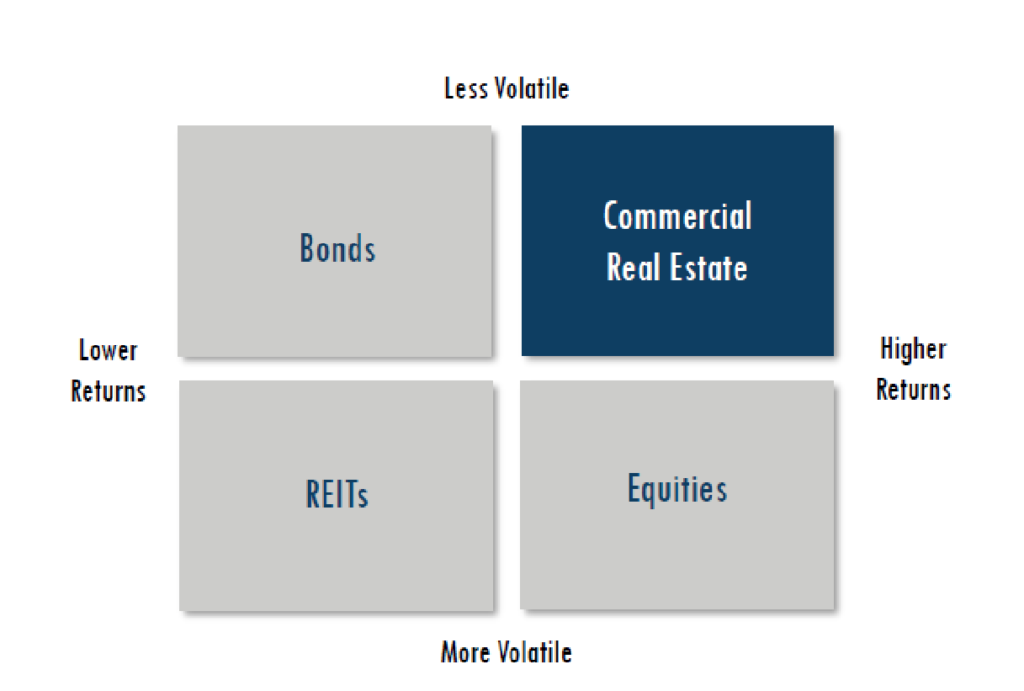
Commercial Real Estate (CRE) is property used exclusively for business purposes in which the space is typically leased to tenants. CRE is categorized based on how the space is used, with investment activity predominantly focused on four main property types: office, industrial, multifamily, and retail. Investing in Commercial Real Estate offers three primary benefits to individual investors: strong returns, portfolio diversification, and tax efficiency.
Investing for Strong Returns: Opportunity for Cash Flow and Appreciation
Making investments in commercial real estate offers investors the ability to generate high returns. Total return measures both appreciation and cash flows to quantify the amount of money an investment earns over time, which is then expressed as a percentage gain (or loss) on the initial investment.
According to data provided by Prequin, a research firm that tracks the performance of alternative investments, a $100,000 investment in CRE beginning on January 1, 2001 would have been worth $380,000 on March 1, 2017. A $100,000 investment in the S&P 500 would have grown to just $255,000 over the same period.
Investing for Diversification: CRE Investments have a Low Correlation to Traditional Investments (Stocks and Bonds)
Most investors are comfortable with a mix of stocks and bonds in their investment portfolios — until the markets’ ups and downs start making them nervous. Holding commercial real estate enables investors to temper the volatility in their portfolios because it is immune to the daily shocks of trading.
Commercial real estate values do not adjust on a daily basis, but rather appreciate slowly over time. This “value stability” feature is why private CRE investments are less volatile than their public counterparts. Public and private investment vehicles both have pros and cons, and the optimal portfolio has a combination of both. Public markets are volatile but offer liquidity, while private investments are stable but illiquid.

Investing for Tax Efficiency: The Hallmark of CRE Investments
Tax shelter is arguably the most beneficial component of CRE investing, as the income generated by a property is generally sheltered by depreciation. This key component of CRE provides investors with the long-term benefit of substantial cash flow coupled with minimal tax burden.
Additionally, any long-term value appreciation above the original purchase price will be subject to a lower long-term capital gains rate, as opposed to higher marginal income tax rates.
Finally, because private equity real estate is typically held in a passthrough entity, such an LLC, 100% of income, losses, and expenses are passed through to the owners. Unlike corporations, where owners may be subject to double taxation (the corporation pays taxes on corporate net income and the owner pays on any dividend income they receive), the LLC itself does not get taxed. Instead, individual members are taxed on their share of the income, expenses, and losses reported on their year-end tax document, the K-1. Investors are taxed at their personal income tax rate, which is often lower than that of a corporation.
How to Invest in Commercial Real Estate
Individuals can invest in commercial real estate by acquiring assets as a direct buyer (active investment) or by investing with a private real estate firm (passive investment).
Most private real estate investment companies invest other people’s money alongside their own capital in CRE. Pensions, insurance companies, endowments, family offices, and wealthy individuals are all common investment partners for a private real estate investment company.
Institutional investors have long understood the merits of holding private real estate in their portfolios and have relied on this asset class to bolster portfolio returns, balance market uncertainty, and generate tax advantages. In fact, most endowments and pension funds have 10% – 15% of their investment portfolio allocated to real estate.
More recently, individual investors have caught onto this investment strategy and have begun to add CRE to their investment portfolios.
If you would like to build a better portfolio, click here to download our comprehensive guide to private real estate investing.









